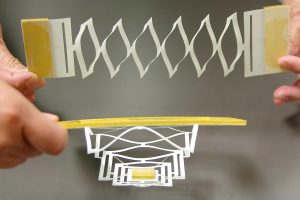Have you ever seen someone fold a piece of paper and make little cuts in it — like the way you would make paper snowflakes?
Now imagine folding, twisting, and bending a sheet of graphene that’s only one-atom thick in the same manner. The art is called kirigami, and physicists from Cornell University have been practicing on super-thin sheets of graphene to find that the material is actually a lot like paper.

What that means is that a future filled with more flexible and stretchier electronics is in the works.
To discover the real strength and flexibility of graphene, researchers used one-atom-thick sheets of hexagonally bonded carbon — known for being very thin, very strong, and a great electron conductor and then practiced the art of kirigami on 10-micron sheets of graphene using a laser cutter. If you want an idea of how thin that really is, a human hair is 70-microns thick.
“It was really true exploration, cutting things out of paper and playing with them, trying to imagine how a ‘hanging kirigami mobile for kids’ could become a nanoscale spring for measuring forces or interacting with cells,” said Melina Blees, a former physics graduate student and now postdoctoral researcher at the University of Chicago, who originally worked on this project.
Playing with kirigami showed the researchers that there was really no difference in practicing the art on paper or graphene and the practice could lead to tiny, yet resilient and movable parts like hinges and stretchable electrodes made out of graphene.
“It’s one thing to read about how strong graphene is; it’s another thing entirely to crumple it up and watch it recover, or to stretch a spring dramatically without tearing the materials,” said Blees. “It’s not every day that you get to develop a feel for a nanoscale material, the way an artist would.”
Their work was published in The journal Nature on July 29.

